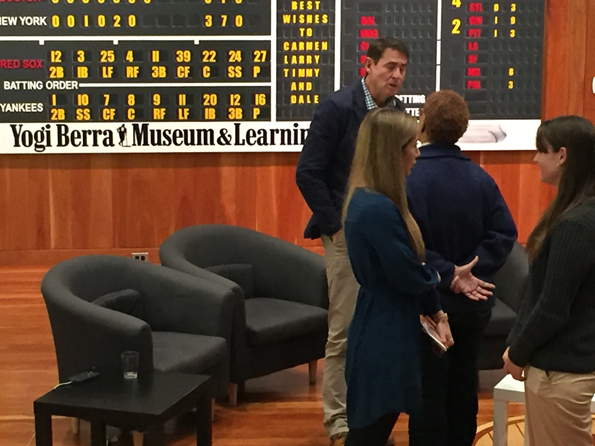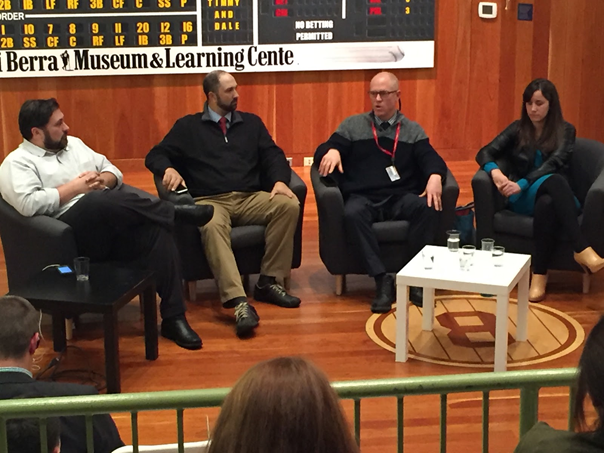The Yogi Berra Museum and Learning Center at Montclair State was taken over recently by panelists from various sectors of the sports journalism field.
The biggest name on the list of the Nov. 9 panelists was the USA Softball Olympic gold medalist turned ESPN broadcaster Jessica Mendoza, who Skyped in for the session. Mendoza made headlines this past Major League Baseball postseason as the first woman to be a broadcaster for a MLB playoff game.
When talking about her monumental MLB playoff appearance, Mendoza said,“Oh my gosh, when that first pitch was thrown, I was like, ‘Alright, I can do this. This feels good.'”
Mendoza participated in what was the third panel of the day, titled The Athlete as Journalist, in which she and fellow panelists Lindsay Berra of MLB.com, Tim Scanlan, former ESPN Vice President, and Lori Berlin of Champions League Inc., spoke about the recent transitions of former athletes moving to the screen as analysts.
“If you’ve got two people that have played the game and they can both broadcast and communicate, it’s a conversation [on camera] and that’s probably the biggest sea change,” said Scanlan.
The day’s event represented a joint regional meeting of the Association of Women in Sports Media and the Associated Press Sports Editors, hosted for the first time at Montclair State.
The fourth panel of the day moved on to what is seen as one of the biggest explosions in sports journalism today: The Five Tools Journalist.
“Looking at all angles, how do you tell a story visually? How do you tell a story, [through what] words, graphics are there?” asked panelist Diana Nearhos of the Glens Falls Post Star.

Lindsay Berra and other panelists mingle with students and audience members.
Photo Credit: Chris Thompson
The other panelists, including Justin Pelletier of the Lewiston Sun Journal, Hank Winnicki of Newsday, Nearhos, and Montclair State’s own Professor Tom Franklin, who echoed Nearhos’ comments, spoke about the need for journalists in today’s world to do much more than was asked of them in the past.
Franklin identified the essentials of journalism as “the ability to shoot pictures, to transmit them quickly and immediately, with captions, with pertinent information and then send higher quality pictures later on for the print edition and, in some cases, write a short text block for the web story. Your reporting skills have to be significantly stronger.”
With the exception of Nearhos, the three other panelists all started in the journalism business long before technology got to the point to where it is today. They spoke about how they adapted to this changing journalistic field, being that they started in a world without Twitter, Facebook and cameras everywhere.
“The responsibilities of a visual journalist working today are, you know, ten times what they were ten or fifteen years ago,” said Franklin.
Given that social media has become such a big aspect of news coverage, naturally there was a panel dedicated to the infamous trolls of social media, specifically those focused towards women.
Montclair State Journalism Professor Kelly Whiteside led this panel, featuring women from the New York Daily News, USA Today, and ESPN. It focused largely on the fact that women in the media face much more criticism and backlash from sports fans, who believe they may not know what they’re talking about.
“I’m just trying to go after the people that really just care about the game and just want to talk about that,” said Mendoza on this topic. “Those are the ones that I care that are listening.”
Data journalism was another intriguing topic of discussion. The website for the data journalism handbook describes this style of reporting as something that “can help a journalist tell a complex story through engaging infographics.” It’s a way that the sheer amount of information in today’s online world can somehow be quantified, so as to paint a deep picture of what is really going on in a story.
Panelists included a mix of online and print writers from The New York Times, The Boston Globe, FiveThirtyEight, Syracuse.com and The Washington Post. They spoke about the different ways to tell stories, finding ways to somehow use the unbelievably vast amount of information available in today’s world, a curse and a blessing at the same time for today’s journalists.
“It’s just finding different ways to tell a story, which is kind of a nice beginning and end,” said Nearhos.



